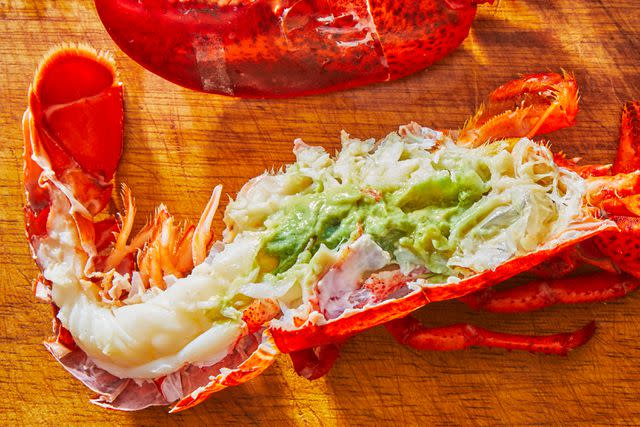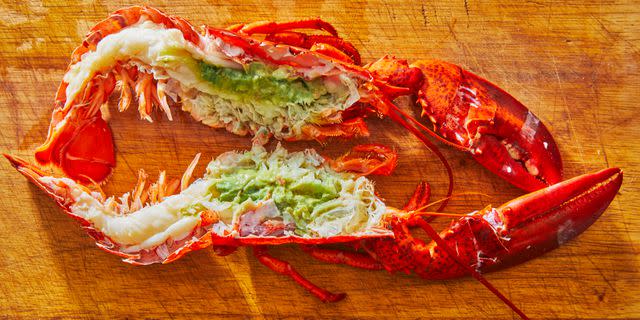What's The Green Stuff In Lobster?
Get to know more about tomalley.
If you’re a seafood lover, you’re likely excited when lobster season comes around. Whether you’re well-versed in eating this crustacean or eating lobster for the first time, you’re going to come across a greenish paste, known as tomalley. Here's what it is—and whether you should eat it or avoid it.
What’s the Green Stuff?
Tomalley functions as both the liver and pancreas for a lobster’s digestive system. When the lobster is cooked, the digestive organs change color.
"Tomalley, the digestive gland of a lobster, turns green when cooked,” says Will Brady, executive chef of YŪGŌ Oxford in Mississippi. Some may refer to it as a lobster paste. For anyone who hasn’t tried it, Brady describes the flavor as “the same flavor as a lobster, just richer and smoother in texture."

Caitlin Bensel; Food Stylist: Torie Cox
Why Is Tomalley Considered a Delicacy?
James Lubin, owner and head chef of Florida-based Semaj’s One Way Catering, says that it’s considered a delicacy for its creamy texture and bold sealike shellfish flavor.
Limited access and availability makes tomalley even more sought-after, helping it reach delicacy status. There is a supply and demand issue at hand, due to the small amount available, says Brady. “You are only able to get one to two tablespoons out of each whole lobster; the same idea as caviar."

Caitlin Bensel; Food Stylist: Torie Cox
How To Use Lobster Paste
Some people love scooping it up and savoring a couple of bites when eating a whole lobster. But this tasty gland can be used in sauces, soups, as a spread, or even added to butter.
"It is an excellent thickening agent for seafood sauces or even lobster bisque," says Lubin. "It is also used in pate form to spread on a crostini or tea sandwiches."
Where you live will also influence how you eat and prepare this special ingredient.
"Whipped with butter and fresh herbs, many Northeasterners offer this as a topping on toasts,” says Brady. But as a Southern chef, he prefers using tomalley for seafood dishes.
"As a chef in the South, I find it enjoyable to be used in a low country boil to enhance flavors and thicken the broths we are using to boil the seafood being served," says Brady.
Lubin likes to use lobster paste to make a spread for a club sandwich. I would use it in aioli to bump up the flavor profile to make a tasty lobster club with grilled pineapples, which is great for a summertime picnic. Tomalley can also be added to clarified butter to dip your lobster in for additional flavor, shares Brady.
Purchasing Lobster With Tomalley
Because this paste is the digestive gland of the lobster, it doesn’t matter whether you buy a fresh or frozen lobster. If you purchase from a fish counter, you can ask them to remove the pancreas and liver.
According to Brady, "When buying, if you wish to have the fishmongers split your lobster, you have the choice for it to be left in or taken out."
There’s a slight difference in texture, depending on if it’s a male or female lobster. Wondering how to tell a male and female lobster apart? "Male lobsters have larger legs and a straight tail while female lobsters have a wider tail that is slightly curved,” says Brady.
If someone else has cooked the lobster, you can tell based on the color. “The males have a green tomalley while the females have more of a yellow-tinted tomalley,” says Brady. And for the experienced lobster eaters, you likely will be able to tell because female lobsters have a smoother texture. “My personal preference is the female tomalley for a nicer color and thicker texture,” says Brady.
Is It Safe To Eat?
Most people can handle eating a lobster’s digestive glands on occasion. “The bodies of most healthy individuals can sustain consuming moderate amounts of tomalley,” says Lubin. Because it’s where everything the lobster consumes is processed, tomalley may contain toxins.
Consuming in moderation is recommended. "Eating too much tomalley can have negative effects on the human body,” says Brady. “For example, mercury and other toxins associated with eating the livers and glands of animals can harm the body if too much is consumed."
Cooking lobster won’t minimize the toxins found in a lobster. “Toxins found in the meat of lobster are safe to eat but since tomalley is found in the digestive tract it is not water-soluble [and] the toxins will not be eliminated when cooked,” says Lubin.
Who Shouldn't Eat It?
If you have a sensitive system, you likely want to skip this delicacy. “If you have a weakened immune system, it is not recommended to consume tomalley,” says Lubin.
For more Southern Living news, make sure to sign up for our newsletter!
Read the original article on Southern Living.

